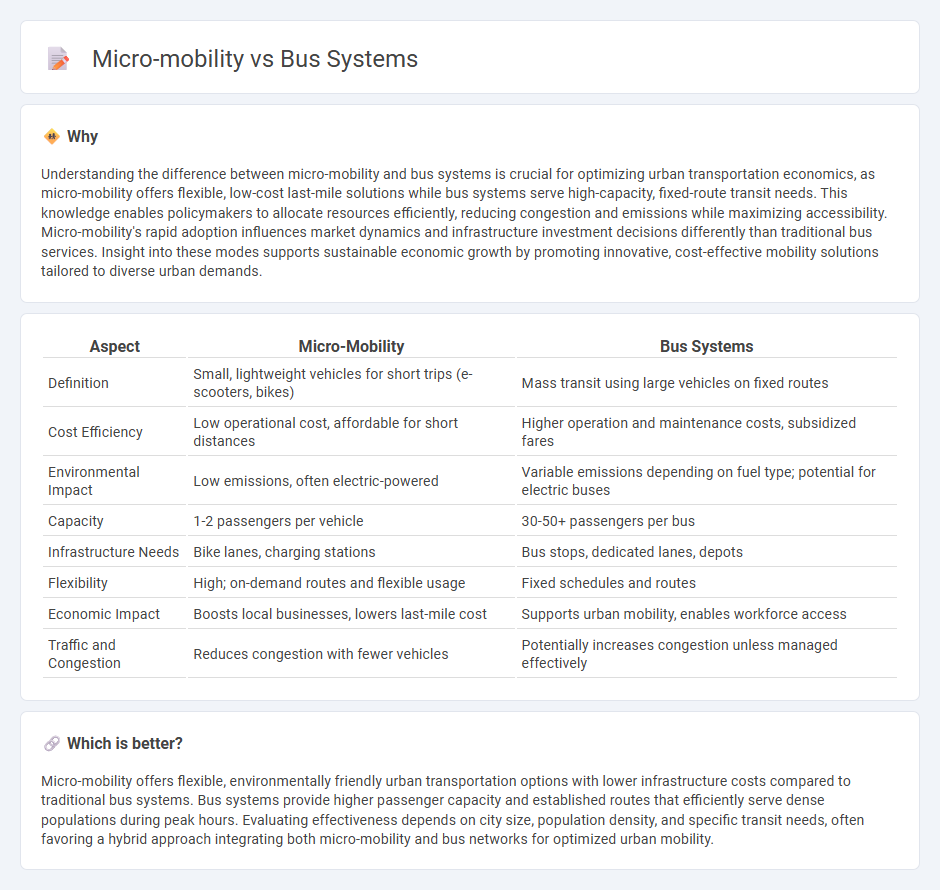
Micro-mobility solutions such as e-scooters and bike-sharing offer flexible, low-cost transportation alternatives with reduced environmental impact compared to traditional bus systems, which provide higher passenger capacity and fixed-route reliability. Urban areas investing in micro-mobility infrastructure report decreased traffic congestion and improved last-mile connectivity, complementing existing public transit networks. Explore detailed comparisons on efficiency, cost, and sustainability of micro-mobility versus bus systems to understand their roles in modern urban economies.
Why it is important
Understanding the difference between micro-mobility and bus systems is crucial for optimizing urban transportation economics, as micro-mobility offers flexible, low-cost last-mile solutions while bus systems serve high-capacity, fixed-route transit needs. This knowledge enables policymakers to allocate resources efficiently, reducing congestion and emissions while maximizing accessibility. Micro-mobility's rapid adoption influences market dynamics and infrastructure investment decisions differently than traditional bus services. Insight into these modes supports sustainable economic growth by promoting innovative, cost-effective mobility solutions tailored to diverse urban demands.
Comparison Table
| Aspect | Micro-Mobility | Bus Systems |
|---|---|---|
| Definition | Small, lightweight vehicles for short trips (e-scooters, bikes) | Mass transit using large vehicles on fixed routes |
| Cost Efficiency | Low operational cost, affordable for short distances | Higher operation and maintenance costs, subsidized fares |
| Environmental Impact | Low emissions, often electric-powered | Variable emissions depending on fuel type; potential for electric buses |
| Capacity | 1-2 passengers per vehicle | 30-50+ passengers per bus |
| Infrastructure Needs | Bike lanes, charging stations | Bus stops, dedicated lanes, depots |
| Flexibility | High; on-demand routes and flexible usage | Fixed schedules and routes |
| Economic Impact | Boosts local businesses, lowers last-mile cost | Supports urban mobility, enables workforce access |
| Traffic and Congestion | Reduces congestion with fewer vehicles | Potentially increases congestion unless managed effectively |
Which is better?
Micro-mobility offers flexible, environmentally friendly urban transportation options with lower infrastructure costs compared to traditional bus systems. Bus systems provide higher passenger capacity and established routes that efficiently serve dense populations during peak hours. Evaluating effectiveness depends on city size, population density, and specific transit needs, often favoring a hybrid approach integrating both micro-mobility and bus networks for optimized urban mobility.
Connection
Micro-mobility solutions like e-scooters and bike-sharing complement bus systems by providing efficient first- and last-mile connectivity, increasing public transit accessibility and reducing reliance on private vehicles. Integrating micro-mobility with bus networks enhances urban transit ecosystems, optimizes route coverage, and drives sustainable economic growth through reduced traffic congestion and lower carbon emissions. Cities adopting coordinated fare systems and infrastructure investments witness improved ridership and more resilient transportation economies.
Key Terms
Cost Efficiency
Bus systems offer high cost efficiency by transporting large numbers of passengers with relatively low per capita operational expenses, making them suitable for densely populated urban areas. Micro-mobility solutions like e-scooters and bikes have lower infrastructure costs and provide flexible, last-mile connectivity but can incur higher maintenance and replacement expenses. Explore detailed analyses on cost factors influencing public transportation and micro-mobility economics to optimize urban mobility investments.
Scalability
Bus systems offer high scalability by accommodating large passenger volumes on fixed routes, making them ideal for densely populated urban areas. Micro-mobility solutions, such as e-scooters and bike-sharing, provide flexible, last-mile connectivity but face challenges in scaling due to limited capacity and infrastructure requirements. Explore how combining these transportation modes can optimize urban mobility and scalability.
First-mile/Last-mile Connectivity
Bus systems offer extensive coverage and high passenger capacity, making them effective for core transit routes but often less convenient for First-mile/Last-mile connectivity due to fixed stops and schedules. Micro-mobility options such as e-scooters, bikeshares, and e-bikes provide flexible, on-demand transportation that efficiently bridges the gap between transit hubs and final destinations, reducing reliance on private vehicles. Explore the latest research on integrating bus networks with micro-mobility solutions to enhance seamless urban mobility.
Source and External Links
Bus (computing) - Wikipedia - A bus in computing is a communication system that transfers data between components inside a computer or between computers, including hardware and protocols used for orderly data exchange.
List of bus transit systems in the United States - Wikipedia - This provides a detailed list of operating public bus transit systems across US cities, including ridership, number of vehicles, and coverage, excluding private and charter buses.
Maps & Schedules - Ride - WeGo Public Transit - Offers real-time bus location, schedules, route maps, and alerts to assist riders in planning and tracking transit trips efficiently.
 dowidth.com
dowidth.com